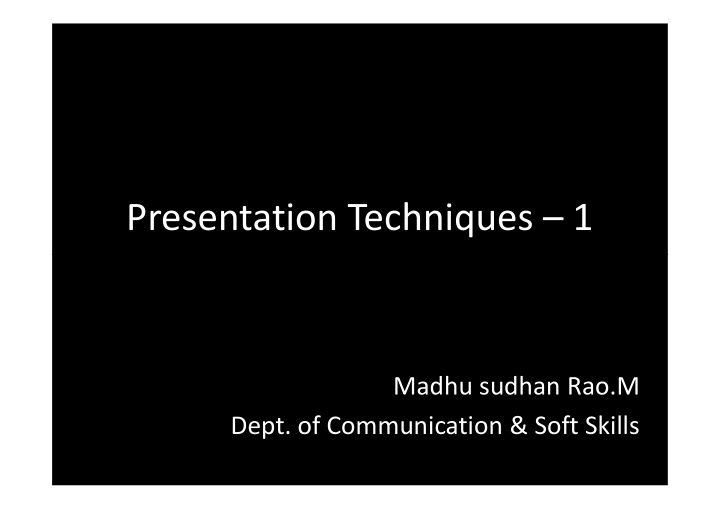



Presentation Techniques – 1 Should you require this or any other handout in a different format, please let us know Madhu sudhan Rao.M Dept. of Communication & Soft Skills
Aims – To increase your understanding of what makes a good presentation – To look at some common pitfalls and how to avoid – To look at some common pitfalls and how to avoid them – To develop practical strategies for planning and delivering effective presentations
Four key elements of a good presentation: AM PM Audience – where are they coming from? – what do they need to know? Message Message – what are the most important things to get across? Presenter – how to present with impact? Medium – what’s the most effective medium to use? – how to control it?
Thinking about your audience • How would you present your course if you were talking to: Audience Audience – A group of 6th form students – A group of 6th form students – Your tutors – A community group of elderly people
Describe someone you respect or your favorite celebrity and explain why you like them.
Thinking about your message Message Message
Message - what? Selecting material • How much time do you have? (Practice to make sure it fits!) • What key messages do you want to get across? • What key messages do you want to get across? • Brainstorming – can be used by groups or individuals • When working in groups – must be supportive of every contribution • Visualise ideas – create a mind map
Use mind mapping techniques to generate ideas for content
Use Mind Genius to generate ideas Organisational Interest Team work Why me? Skills numerical Skills Skills Experience Experience Summer vacation job in Summer vacation job in IT literate environmental conservation Member of British Trust for Communication Conservation Volunteers Experience Confidence Member of RSPB Sixth form field work
Message - How are you going to structure it? Beginning Middle End decide the outline the summarise the best content and your main points message angle and grab and restate order for their attention your angle logical flow of ideas
…or Tell ’em Tell ’em Tell ’em what what you Tell you’ve are going ’em just told to tell ’em ’em
Thinking about your message Presenter Presenter
You the presenter How confident are you in: – Using your voice (clarity and volume)? – Using body language (gestures, facial expression)? – Using body language (gestures, facial expression)? – Timing (speed, detail, length)? – Dealing with nerves? – Responding to audience (eye contact, changing pace given cues)?
Feeling tense? What do you do when you are nervous? What strategies can you adopt to overcome them?
Effective Communication • Know about what you want to say. • Look at people when you speak to them. • Speak clearly and keeping what you say simple and uncomplicated. • Ensure that your words, body language and voice match what you are saying. • Give clarity to what you are communicating by attending to signs of other people’s confusion, resentment or lack of interest. • Summarise and check that people understand you.
Thinking about your message Medium Medium
Using different mediums • Flip Chart and Poster presentations – Clear and concise – Visual impact – Well organised • • OHTs OHTs – File in ring-binder – use clear plastic wallets to store and organise – Test the equipment – check focus and visibility • Prompt cards – Hole punch and tag – Subdivide into sections with one or two prompt words – Use highlighters to attract the eye, but not too much detail
Font and Transition If you use a small font, your audience won’t be able to read what you have written CAPITALISE ONLY WHEN NECESSARY. IT IS DIFFICULT TO READ. Avoid complicated / distracting transitions COMPLICATED FONTS ARE COMPLICATED FONTS ARE COMPLICATED FONTS ARE COMPLICATED FONTS ARE DIFFICULT TO READ DIFFICULT TO READ DIFFICULT TO READ DIFFICULT TO READ
Colour Using a font colour that does not contrast with the background colour is hard to read Using colour for decoration is distracting and annoying. Using colour for decoration is distracting and annoying. Using a different colour for each point is unnecessary Using a different colour for secondary points is also unnecessary Trying to be creative can also be bad
Background – Bad Avoid backgrounds that are distracting or difficult to read from Always be consistent with the background that you use
Learning from feedback Complete the presentation skills self audit: • How do you rate your own presentation skills? • • What have you just learnt about your strengths and weaknesses? What have you just learnt about your strengths and weaknesses? • What strategies and techniques will you adopt to improve your performance?
Remember 1. The higher you climb the further you fall – technology can and often does let you down. 2. Don’t make any assumptions about technology. It is your responsibility to check what is in a room and what you can responsibility to check what is in a room and what you can use confidently. 3. Make sure the equipment you are using to deliver your presentation can support the media you wish to use. 4. Check all sound card volume controls before starting.
Session Objectives Recap • To increase your understanding of what makes a good presentation. • To look at some common pitfalls and how to • To look at some common pitfalls and how to avoid them. • To develop practical strategies for planning and delivering effective presentations.
Presentation techniques - 1 Question Hour Question Hour
Recommend
More recommend